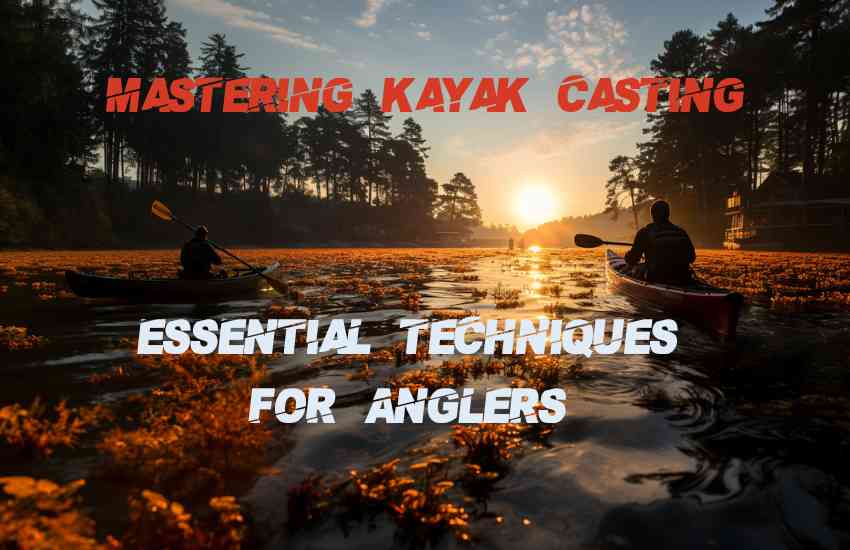5.1Mastering Kayak Casting: Essential Techniques for Anglers

Welcome to the section on casting techniques from a kayak. Casting techniques from a kayak provide a unique challenge and opportunity for anglers. The experience is truly different from casting on dry land or a larger vessel. Kayaks offer mobility and access to areas that other boats cannot reach, but they also require specific skills and an understanding of casting techniques. This section will cover those techniques based on my years of experience as a kayak angler.
After completing this article, you will learn:
- The importance of adapting your casting techniques for kayak fishing.
- Various casting techniques to utilize while fishing from a kayak.
- How to overcome challenges specific to kayak casting.
- Equipment recommendations to enhance your casting abilities.
- Tips for improving accuracy and distance with your casts.
Perfecting Overhead Casting, Sidearm Casting & Pitching
Overhead Casting
Overhead casting is a fundamental skill in kayak fishing, allowing you to cast great distances with precision. It is useful when you want to cover a broad area or reach a distant target. Here’s how to do it:
- Position Yourself Correctly: Ensure that you are sitting upright in your kayak and your body is aligned with the target.
- Load the Rod: Allow the rod to bend slightly by pulling it backward over your shoulder, forming a roughly 45-degree angle.
- Cast Forward: In a controlled motion, cast the rod forward by releasing the tension and letting the line fly towards the target.
- Control the Reel: Feather the spool with your thumb to control the distance and accuracy.
Once, while fishing on Lake Michigan, my overhead cast wasn’t reaching the distance I wanted. By adjusting the angle and working on a fluid wrist motion, I was able to achieve the desired distance and catch a nice-sized bass. Practice will make your overhead casts more accurate and effective.
Sidearm Casting
Sidearm casting is ideal for situations where you need a lower trajectory or are fishing in areas with obstacles such as overhanging branches.
- Align the Rod: Hold the rod horizontally to the water, aligning it with your target.
- Swing Sidearm: Using a smooth motion, swing the rod sidearm, releasing the line towards your target.
- Control the Distance: As with overhead casting, feather the spool to control the line’s distance and trajectory.
I was fishing in the mangroves of Florida’s Mosquito Lagoon, and overhead casting was impossible due to the low-hanging trees. Sidearm casting allowed me to navigate the lure under the branches, and I managed to hook a beautiful redfish. It proved to be a fantastic solution to the challenge presented by that environment.
Pitching
Pitching is a subtle casting technique used to present the bait softly to the target without alarming the fish. It’s especially useful in clear and shallow waters. Here’s how to do it:
- Hold the Lure: Grab the lure or bait with your free hand while keeping the rod tip high.
- Swing the Lure: Release the lure and allow it to swing towards your target.
- Control the Descent: As the lure approaches the water, control its descent by manipulating the reel.
During a quiet morning on the Arkansas River, I needed to target a bass hiding near some reeds. Traditional casting would have scared it away. I used pitching to place the lure precisely without startling the fish. It took some practice, but the reward was well worth the effort.
Precision Casting: Targeting Structure and Cover
Precision casting is the art of placing your lure exactly where you want it, typically around structures such as rocks, logs, or weed beds. These areas often hold fish, but they also pose challenges due to the risk of snagging.
Understanding the Target
Before casting, analyze the structure or cover you’re targeting. Look for potential hiding spots for fish, such as crevices in rocks or shaded areas under logs. Plan your cast to reach these specific locations.
Casting Techniques
Use any of the previously mentioned techniques (overhead, sidearm, or pitching) to achieve precision. The key here is control and understanding of how your lure behaves in the water.
Problem-Solving
If you find your lure getting snagged, don’t panic. In my years of experience, I’ve learned a few tricks to free a snagged lure:
- Gentle Pulling: Try gently pulling and releasing the line to allow the lure to work itself free.
- Change Angles: Sometimes, changing the angle of pull can free the lure.
- Use a Snagging Tool: If all else fails, a specialized snagging tool can help retrieve your lure.
One memorable day, I was fishing on Lake Tahoe’s rocky area, known for its big bass but also notorious for snags. A promising cast ended up snagged between rocks. By carefully working the line from different angles, I was able to free the lure and continue fishing. It’s these little techniques that can save your day and your gear.
Final Talk
Casting techniques from a kayak offer a rich and rewarding fishing experience. The art of perfecting these techniques comes with practice and understanding. Overhead casting, sidearm casting, and pitching are essential skills, while precision casting allows you to target structure and cover effectively.
Remember, patience and practice are key. I’ve learned these techniques over many years of kayak fishing, and so can you. Refer back to this chapter as needed, and don’t be afraid to experiment and learn from your experiences on the water.
Next, in Section 5.2: Choosing the Right Kayak and Gear, we will delve into selecting the right equipment to complement these casting techniques and ensure a successful and enjoyable kayak fishing trip. An invitation to read the next section remains. Whether a novice or an experienced angler, the right gear makes all the difference.